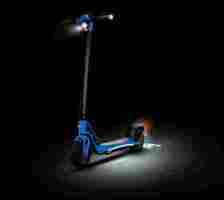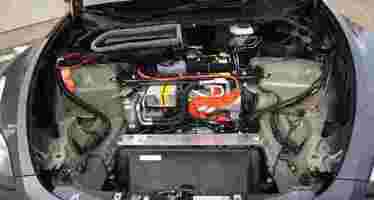New extinguisher addresses unique challenges of fighting EV fires
Contrary to what many skeptics preach, there’s not enough data yet to confirm that EVs are more likely to catch fire than internal combustion engine cars.

But there’s un irrefutable fact: when electric vehicles do catch fire, they burn fiercely and require a new skillset for emergency respondents to fight the flames.
Austrian firefighting equipment manufacturer Rosenbauer has developed a special EV fire extinguisher, specifically designed to tackle the complexities of EV fires , Rideapart reports.
But first, things first. What makes electric car fires unique?
The issue is the lithium-ion batteries that power EVs up. They store a huge amount of energy in a very small space.
As Professor Paul Christensen from the University of Newcastle explained to Air Quality News , “if the battery is exposed to excessive heat, or there is a penetration in the battery case, then you get an internal short circuit.”
Simply put, this short circuit causes excessive heat, which in turn causes a chemical reaction that generates more heat, making the chemical reaction to develop even faster, which results in more heat — a vicious circle.
This process is called “thermal runaway” and it’s basically what’s generating EV fires.
Due to their intensity, they require larger amounts of water to be put out. According to the Confederation of Fire Protection Associations of Europe , firefighters need more than 60,000 liters of water and a flow rate of 1100 liters per minute to even tackle an EV fire.
Firefighters also need to prevent the water from flowing into drains because of the toxins the water picks up from the burning batteries.
During an EV fire, over 100 chemicals are generated from the battery, including toxic gases such as carbon monoxide and hydrogen cyanide, which are fatal to humans.
Electric vehicle fires can reignite minutes, hours, or even days after the initial event.


The company’s system consists of two parts: an extinguishing unit and a control unit.
The extinguisher can be placed under the vehicle, on the top, or even in the interior to best access the battery. Notably, the extinguisher pumps water directly into the battery, which, as the company notes, makes the cooling process faster and more efficient.
This, in turn, reduces both the amount of water required and the amount of harmful smoke and gases released along the way.
The extinguisher is connected to the control unit, operated by firefighters at a safe distance, 7.6 meters away from the vehicle.
And here’s another plus: once the fire has been put out, the extinguishing unit can be left attached to the car during transport. So in case of reignition, the system is already in place and can reduce response time.
Having completed testing in various battery designs ( pouch, prismatic, and round cells), Rosenbauer will move into production. Fire brigades can pre-order the system now and units will arrive in early 2022.
Personally, I expect more similar solutions to emerge as the number of electric cars on the road is increasing. Until then, training emergency respondents on the complexities EV fires present is also a necessary step we need to take.
Hold on, is Bugatti’s first EV really just a scooter?
Bugatti produces some of the word’s finest and most expensive cars, so our expectations for its first electric vehicle are sky-high.

And, at CES 2022, we were finally shown what the automaker had in store. Are you ready? Are you prepared? Then — drum roll please — welcome to the world, BUGATTI’S ELECTRIC… scooter?


As strange as it is to see Bugatti’s logo on a two-wheeler, to be fair, it’s a pretty sleek-looking vehicle.
The escooter is foldable and features — according to the company — a “unique aerodynamic design.” Looks like a standard scooter to me. Anyway, this “unique” vehicle has a magnesium alloy frame that keeps weight down to just 15kg.
A 700W motor provides enough juice to climb up to a 15 degree incline, which, coupled with a 36V 10Ah battery, delivers a range between 32km and 45km.
The battery itself is removable and be charged in any standard wall outlet for around four hours.
If, however, you’re expecting a Veyron-like beastly performance, you’ll be somewhat disappointed. The escooter has three drive modes: Economy, City, and Sport, good for top speeds of 14km/h, 20km/h, and 30km/h, respectively.
That’s actually on par with most escooters on the market and doesn’t really reflect Bugatti’s motto “ If comparable, it is no longer Bugatti .”
Oh, well. We can’t have everything.
Other cool features include a digital dash that displays speed, mode, battery life, and headlights, and — my favorite — a monogrammed rear light that projects the famous “RB” logo onto the ground behind the rider.
Bugatti has also gone big with the lights to increase safety. The scooter features illuminated base lights on the sides of the deck and back, plus it has dual-turn signals on the handle grips, as well as above the rear mudguard.
Bugatti didn’t develop the electric two-wheeler on its own. Instead, it joined forces with Bytech International , a tech accessory company that makes everything from phone holders to Bluetooth speakers.
As per Wiebke Stahl, Managing Director at Bugatti International:
While it feels weird to associate Bugatti with anything other than its famous cars, the automaker isn’t the first to start dipping into the micromobility market.
Porsche has its own ebikes, SEAT escooters, and even BMW has dabbled.
After all, the micromobility market is projected to reach $195.2 billion by 2030 — and who wouldn’t want a piece of that cake?
There’s no word yet on when the Bugatti-Bytech scooter will be available or how much it’ll cost for that matter. My guess is that bearing the Bugatti name, it’s gonna be more expensive than regular consumer models. And it might be worth it for that Batman-style rear light alone.
What’s a heat pump and why do EVs use them?
Welcome to SHIFT Basics , a collection of tips, explainers, guides, and advice to keep you up to speed with mobility tech.

They’ve been hailed as a money saver , an essential feature for EVs, and in some cases: a game changer . What am I talking about? Heat pumps of course!
The idea is that heat pumps prevent excess heat created by an EV’s battery and drivetrain from going to waste. They absorb the excess heat generated by EV ‘s battery and drivetrain to improve the car ‘s efficiency, range, and driving experience.
The name sounds simple enough, but what exactly do they do? And why are they important for electric vehicles? Let’s dive in and answer some of those questions.
What is it?
Put simply, a heat pump is a device used to move heat around an electric vehicle. Similar concepts are used in combustion engine cars, but we don’t care about those right now.
Reversible heat pumps can also generate heat, and then move that around an EV as it’s needed, but we’ll get on to that later.
Let’s go deeper
But why do we need to move heat around? Well, to be honest, we don’t. We could simply cool the battery and motors, and dump that heat back into the atmosphere using radiators. But that’s kind of wasteful, and that’s not at all in the spirit of electric vehicles.
One core function that heat pumps perform, is to take heat away from the hot parts of the car that would otherwise be wasted, and direct it to the passenger cabin. This means that the EV doesn’t need to use its battery to power a resistive heater, to keep passengers comfortable.


Less use of the main battery means improved range and improved efficiency. See how this is working? It’s really simple. This is all fine when temperatures outside the vehicle are just cool, but what about when it’s much much colder?
What about when it’s freezing?
Reversible heat pumps also have the ability to generate heat, which can be incredibly useful when ambient temperatures outside the vehicle are below freezing.
The downside of electronics, like batteries, motors, and computer chips, is they perform best in a very narrow temperature window. As cold climate EV drivers know, an ice-cold battery is very inefficient and can have a detrimental impact on range. Here’s where reversible heat pumps come in.
As mentioned, reversible heat pumps can also generate heat. They do this by compressing the refrigerant that flows through the cooling system — under compression, refrigerants get hot.
That heat can then be moved around the car’s cooling and heating system to put heat where it’s needed, for example in the battery.
It’s actually more efficient to use warm the battery before setting off on your journey, instead of waiting for it to warm itself through use. What’s more, as most EVs can “precondition” before unplugging from their charger, you can leave with a warm battery, full of power, that won’t be adversely impacted by the cold weather.
If you’re keen to go into even more detail on how heat exchangers and pumps work, watch this video from Jason Fenske at Engineering Explained over on YouTube.
What’s the fuss?
Hopefully that all makes sense. Heaters can create perfect operating temperatures for the battery in freezing situations. And in non-freezing, but cold, situations they can heat up the cabin and save battery power.
Some claim that Tesla’s heat pump system in its Model Y is 300% more efficient than its resistive heating unit that it has used previously. This can have a dramatic impact on range when driving in cold weather.
Well-known EV reviewer and tester Bjorn Nyland, tested two near identical Tesla Model 3’s , one with a heat pump and one without, and seemed to confirm this boost in efficiency.
Nyland used camp mode, a setting which maintains a cabin temperature, to see how much more efficient the heat pump is compared to the older heating ventilation and air conditioning (HVAC) system. After three hours of maintaining a cabin temperature in frosty Norway, the heat pump-equipped Tesla had lost 3% of battery charge, whilst the older Model 3 lost 10%. Watch his full test here .
It’s not just Tesla that’s using heat pumps, though. Nissan claims to be the first to have used the tech on a mass market EV, and they can also be found in BMW i3s too. If anything, Tesla was kind of late to the party, but is now installing its tech on its new vehicles.
It goes without saying, anything that improves the range and efficiency of an EV is a good thing. Heat pumps get a thumbs up from us.
SHIFT is brought to you by Polestar. It’s time to accelerate the shift to sustainable mobility. That is why Polestar combines electric driving with cutting-edge design and thrilling performance. Find out how .